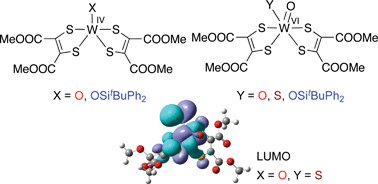A new series of bis(ene-1,2-dithiolato)tungsten(iv), -(v), -(vi) complexes as reaction centre models of tungsten enzymes: Preparation, crystal structures and spectroscopic properties†
Abstract
The carbomethoxy substituted dithiolene ligand (LCOOMe) enabled us to develop a series of new bis(ene-1,2-dithiolato)tungsten complexes including WIVO, WIV(OSiBuPh2), WVIO2, WVIO(OSiBuPh2) and WVIO(S) core structures. By using these tungsten complexes, a systematic study of the terminal monodentate ligand effects has been performed on the structural, spectroscopic properties and reactivity. The structure and spectroscopic properties of the tungsten complexes have also been compared to those of the molybdenum complexes coordinated by the same ligand to investigate the effects of the metal ion (W vs. Mo). X-ray crystallographic analyses of the tungsten(IV) complexes have revealed that the tungsten centres adopt a distorted square pyramidal geometry with a dithiolene ligand having an ene-1,2-dithiolate form. On the other hand, the dioxotungsten(VI) complex exhibits an octahedral structure consisting of the bidentate LCOOMe and two oxo groups, in which π-delocalization was observed between the WVIO2 and ene-1,2-dithiolate units. The tungsten(IV) and dioxotungsten(VI) complexes are isostructural with the molybdenum counter parts. DFT calculation study of the WVIO(S) complex has indicated that the W![[double bond, length as m-dash]](https://www.rsc.org/images/entities/char_e001.gif) S bond of 2.2 Å is close to the bond length between the tungsten centre and ambiguously assigned terminal monodentate atom in aldehyde oxidoreductase of the tungsten enzyme. Resonance Raman (rR) spectrum of the WVIO(S) complex has shown the two inequivalent LCOOMe ligands with respect to their bonding interactions with the tungsten centre, reproducing the appearance of two ν(C
S bond of 2.2 Å is close to the bond length between the tungsten centre and ambiguously assigned terminal monodentate atom in aldehyde oxidoreductase of the tungsten enzyme. Resonance Raman (rR) spectrum of the WVIO(S) complex has shown the two inequivalent LCOOMe ligands with respect to their bonding interactions with the tungsten centre, reproducing the appearance of two ν(C![[double bond, length as m-dash]](https://www.rsc.org/images/entities/char_e001.gif) C) stretches in the rR spectrum of aldehyde oxidoreductase. Sulfur atom transfer reaction from the WVIO(S) complex to triphenylphosphines has also been studied kinetically to demonstrate that the tungsten complex has a lower reactivity by about one-order of magnitude, when compared with its molybdenum counterpart.
C) stretches in the rR spectrum of aldehyde oxidoreductase. Sulfur atom transfer reaction from the WVIO(S) complex to triphenylphosphines has also been studied kinetically to demonstrate that the tungsten complex has a lower reactivity by about one-order of magnitude, when compared with its molybdenum counterpart.

- This article is part of the themed collection: Bioinorganic chemistry

 Please wait while we load your content...
Please wait while we load your content...